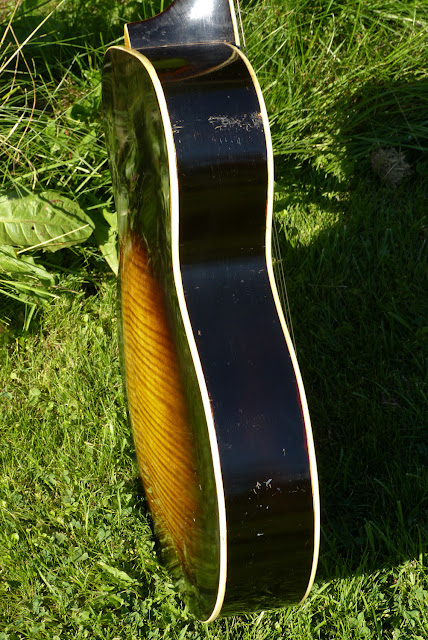1940 Harmony-made Silvertone Royal Archtop Guitar
Carved-top Harmony archtop products are simply rare and I'm jealous of my customer for his owning this box. What's interesting about these is that if you're at all familiar with Harmony's usual pressed-top fare, you can spot a carved-top version a mile away because the sound is easily on-par in the punch/rumble/velvet department with a period Gibson or Epiphone carved-top. Other design elements make it a bit more down-market from your average Gib or Epi, but the sound is certainly there and the folks who carved the top knew what they were doing.
I've blogged about one similar instrument which I pegged as a carved-top a while back and I'm glad to be vindicated by my assumption with this one. They both have the same lightweight, super-thin carving that's quite different from Harmony's pressed-top models -- and the same raw power. Neither model had the "carved-top" red-inked stamp that one finds on some Harmony makes (I've only seen it in two of 5 carved-top Harmony guitars, by the way), but that catalog description of this model makes it pretty clear.
For confirmation, one can check with calipers that the thickness does indeed move around depending on where you are on the top -- something the pressed-tops (mind you, that means solid wood, not lam) don't do as they're heat-molded from flat sheets. The pressed-tops also sound dang "midsy" and lack the low-end growl you want from a "great" archtop.
Anyway, its body shape is pretty average for a Harmony from the time -- 16" on the lower bout and curvy -- and it even has the usual ~25 1/8" scale length.
My work on this one was mostly to repair and cleat up a bunch of cracks on the top and one pretty severe (very wide-open) long back crack. Everything went back together smoothly and then I gave it a fret level/dress, recut the bridge and fitted it a bit better, moved the tailpiece over to align it with the neck, and set it up. The neck deflects under tension (duh, it's a Harmony), but even with the 52w, 38w, 28w, 20w, 16, 12 strings on it, it has an enormous amount of oomph and plays with spot-on action at the 12th fret.
The nut is 1 3/4" and the board has just a hair of radius to it. The celluloid Silvertone headstock veneer is, as they say, "ace."
Thankfully, it appears that the neck must've been reset some time in the past, as its angle was perfectly good to go.
The original Harmony bridges (which feature adjusters that move backwards from normal) leave a bit to be desired, but are perfectly functional. I compensated it a bit better while I was setting it up.
Interestingly, the f-holes are segmented.
I had to fudge around with a shim under the tailpiece to keep the tailpiece wings from bumping into the top now and then. I find that this tailpiece design often gets funky with time. You can have a great neck angle and it'll still get too close for comfort to the top.
The most ironic feature of this guitar is that it has actual maple back and sides and a maple neck (with some figure in it), but the company went ahead and did their somewhat-silly "faux-flamed" finish on it.
The 50s/60s tuners aren't original, but do look the part alright.
The neck has some nicely-figured maple, here and there, where it peeks out from underneath the faux-flamed finish.
This crack was quite wide to begin-with. I'm actually surprised it went back together even this well as nothing was aligned correctly. True to the guitar, I didn't spend the time to gussy it up too much to hide its evidence. There's 6+ more on the top!
Whoever did the neck reset in the past (unless it was factory work, hee hee) didn't align it very well! I had to move that tail right on over. The endpin is a replacement, too -- I bumped the celluloid original and cracked it by accident (sigh).






















Comments